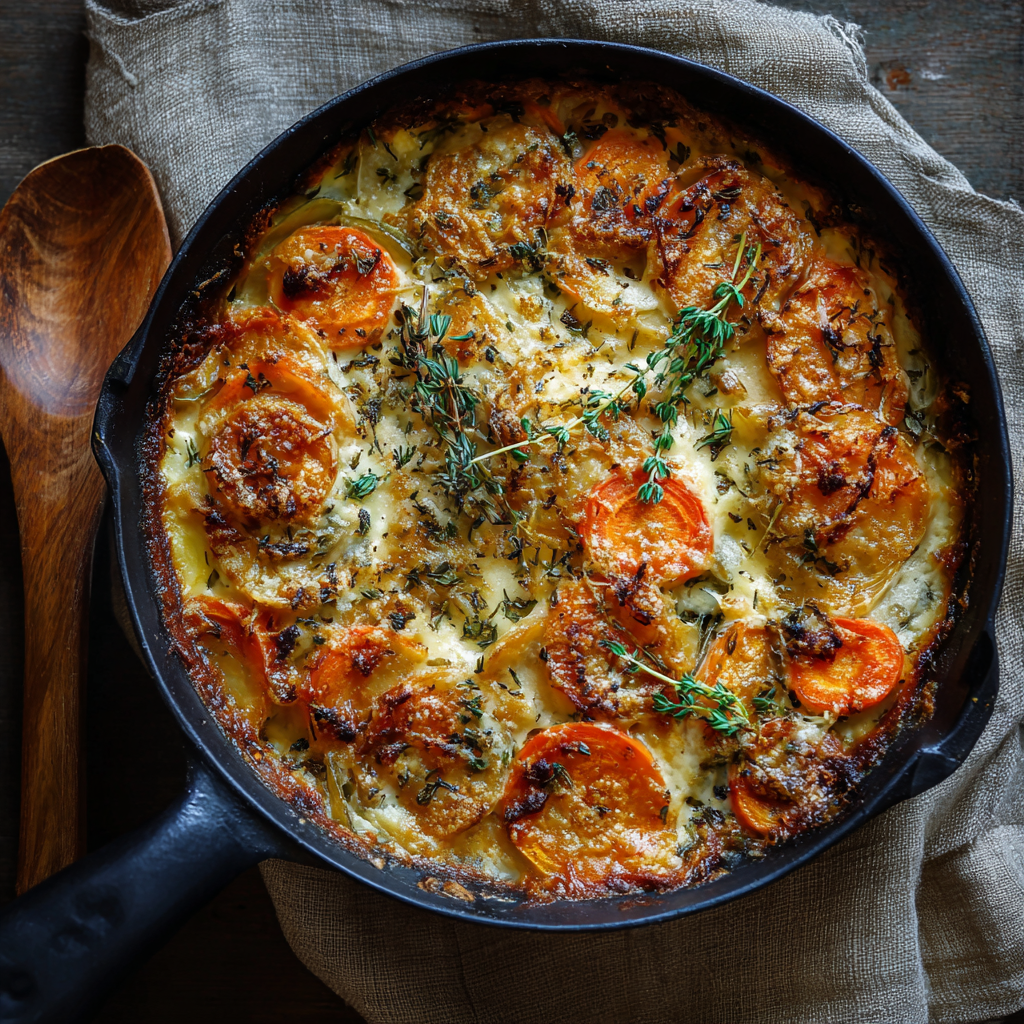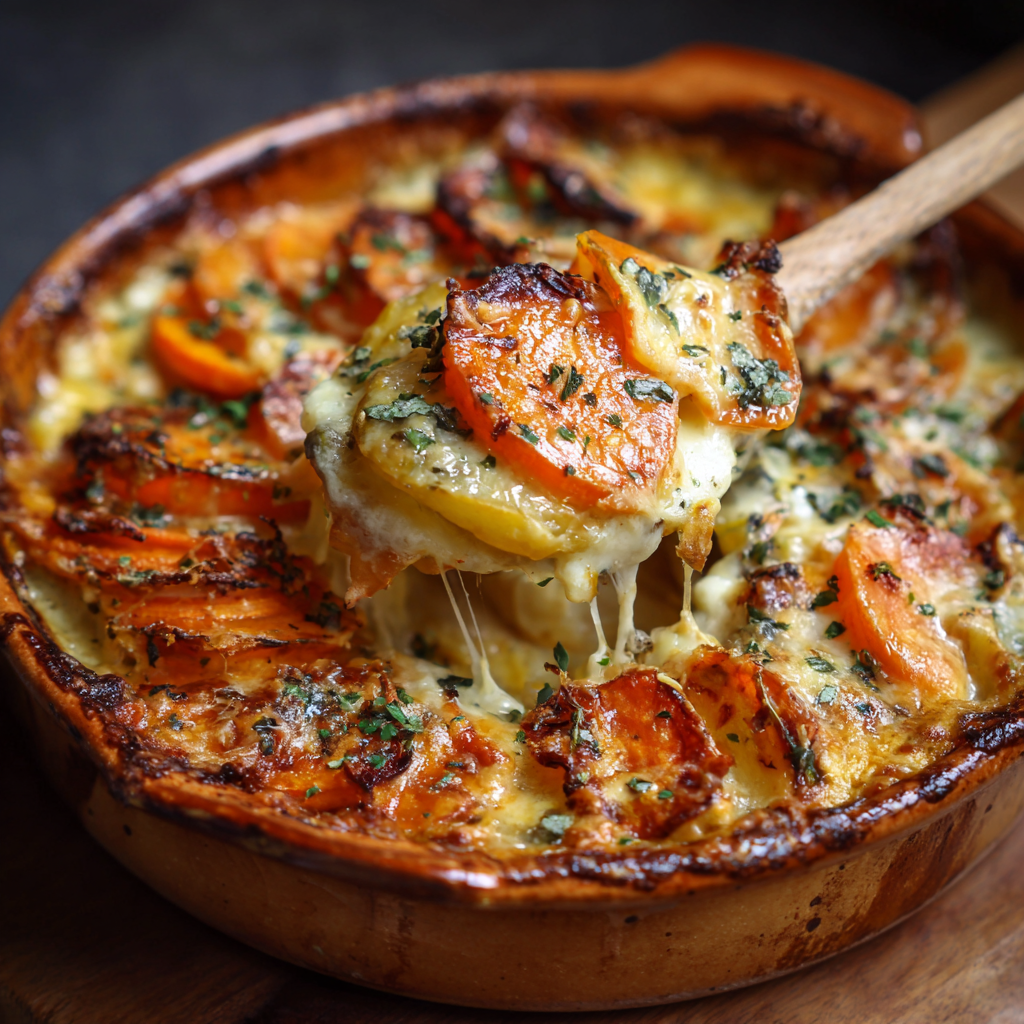When cold evenings settle in, nothing warms the heart like a cheesy root vegetable gratin. This layered bake pairs earthy root vegetables with velvety cream and melted cheese, resulting in a dish that feels both elegant and comfortingly familiar. In this article, I’ll guide you through ingredient selection, techniques, variations, and serving ideas. I’ll also incorporate the keyword cheesy root vegetable gratin repeatedly, and include a link to my recipe hub at nevinrecipes plus a reference to share on pinterest. Let this gratin become a favorite in your home.
Table of Contents
Why Cheesy Root Vegetable Gratin Shines
A Dish That Combines Earthiness and Indulgence
Root vegetables—such as sweet potatoes, parsnips, turnips, beets, and carrots bring natural sweetness, texture, and depth. In a cheesy root vegetable gratin, those flavors become richer, softer, and more unified as they bake beneath creamy sauce and melted cheese. The contrast between tender layers and a crisp, bubbling top makes this gratin unforgettable.
By mixing several roots, you introduce variety in color, taste, and bite. The key is balance: too many similar vegetables reduce interest; too many extremes may compete. A blend of three to five root types usually hits the sweet spot.
Inviting, Versatile, and Memorable
I view this gratin as a bridge between weeknight dinners and special occasions. It’s approachable enough to make any evening feel a little more special, yet striking enough to serve at gatherings. Over time, I adapted it to highlight seasonal roots, rotate cheeses, and adjust cream levels. The result: a cheesy root vegetable gratin that feels personal and soulful.
Because this bake is visually layered and richly aromatic, it draws people in. The golden crust invites serving, and the interior offers comfort in each bite. That’s exactly the kind of dish I love sharing on Nevin Recipes where simplicity, flavor, and joy converge.
Ingredient Selection & Preparation
Choosing Root Vegetables & Setting Quantities
Aim to use 3 to 5 varieties of root vegetables. Some terrific combinations include:
- Sweet potatoes
- Beets
- Parsnips
- Turnips or rutabaga
- Carrots
You’ll want about 3 to 4 pounds (≈1.3 to 1.8 kg) total — enough to fill a standard baking dish in layers. Peel and slice each vegetable into uniformly thin rounds, about 1/8 inch (≈3 mm) thick. A mandoline helps maintain consistency, though a sharp knife works too.
Keep each vegetable type separate when slicing, because some cook faster and some (like beets) bleed. This separation gives you better control in layering and timing.
Cream, Cheese & Seasoning to Elevate Flavor
The magic lies in cream, cheese, and seasoning. Use heavy cream or a blend of cream and whole milk to bind the vegetables and provide richness. You want enough to moisten all slices, but not so much that it turns soupy.
For cheese, consider:
- Gruyère (excellent melt and nutty flavor)
- Comté
- Parmesan (used between layers)
- Fontina or mild cheddar
A mix often gives the best balance: a good melting base cheese, plus a sharper cheese for the top crust.
Season with care. Essential flavors include:
- Fresh thyme or rosemary
- Minced garlic
- Salt and freshly ground black pepper
- A pinch of nutmeg for warmth
These ingredients layer into the bake, accentuating the vegetables rather than overpowering them.
Method & Technique for Best Results
Preheat & Prepare the Baking Dish
Preheat your oven to 375–400 °F (190–200 °C). Generously butter or oil your baking dish so nothing sticks and edges brown well.
Some cooks begin baking in a cold oven to warm gently, then increase temperature toward the end—this can help avoid shock to the vegetables. You may experiment with that method if desired.
Slice & Lightly Season Vegetables
Slice vegetables to uniform thickness. In separate bowls, toss each type lightly with a portion of cream, garlic, thyme, salt, and pepper—just enough to coat. Beets get a little less cream initially to reduce bleeding.
If any slices seem dry, mist them with a little extra cream just before layering.
Layer Vegetables & Add Cream
Arrange vegetables in alternating layers for instance, sweet potato, parsnip, beet, repeat — or fan them in concentric rings. Pour remaining cream evenly so it seeps to lower layers. Optionally, sprinkle Parmesan or seasoning underneath some layers for contrast.
Seal the dish tightly with aluminum foil. This traps steam to help the vegetables cook through without burning the top.
Bake Covered, Then Uncover & Add Cheese
Bake covered for 25 to 35 minutes, or until vegetables begin to soften. Then remove foil, sprinkle on remaining cheese, and bake uncovered for 15 to 25 minutes. The goal is a golden, bubbling crust with fully cooked vegetables beneath.
Monitor carefully toward the end so that the cheese top doesn’t burn. If one side browns faster, rotate or shield parts with foil.
Rest Slightly Before Serving
Allow the gratin to rest for 5 to 10 minutes out of the oven. This setting time helps slices hold together. Finish with fresh herbs or thyme before serving.

Tips, Variations & Presentation Ideas
Pro Tips & Avoiding Mistakes
- Uniform slicing: A must for even doneness.
- Control beet bleeding: Limit cream on beets initially.
- Seal well with foil: Keeps steam inside so inner layers cook.
- Finish uncovered: That melt-and-brown stage defines a gratin.
- Let it rest: Helps the dish set and slice cleanly.
You may assemble the gratin ahead of time, refrigerate, and bake later (adding ~5–10 minutes). Colors might blur slightly, but the flavor remains strong.
Variations to Explore
- Vegan / dairy‑free version: Use cashew cream or a plant-based cream substitute, and dairy-free cheese. Add nutritional yeast or miso to boost savory depth.
- Cheese swaps: Try Gouda, mild cheddar, or sheep’s milk cheese in place of traditional choices.
- Layer aromatics: Lightly sautéed onions, shallots, or leeks add extra complexity.
- Alternate roots: Use celeriac, rutabaga, or celery root to add new textures.
- Sweet contrast: Thin slices of apple or pear add a hint of sweetness amid savory layers.
Serving Suggestions
Serve with a crisp green salad dressed in vinaigrette to offset richness. Pair this gratin with roast chicken, fish, or lean protein to complete a comforting meal. For vegetarian spreads, place it alongside hearty soups or stews.
Leftovers stay good for 3–4 days refrigerated. Reheat covered to retain moisture and protect the cheese top.
Frequently Asked Questions (FAQs)
Can I use just one type of root vegetable?
Yes — it’s simpler that way, though mixing three or more brings better flavor, texture, and appeal.
Is it okay to use milk instead of heavy cream?
Yes. The sauce will be lighter, so you may need more cheese or slightly longer baking to reduce excess liquid.
Can I assemble it the day before baking?
Absolutely. Prepare up to the stage before adding the final cheese topping, cover tightly, refrigerate, and bake when ready (add a few extra minutes). Some bleeding of color may occur, but taste remains excellent.
What if the top crust browns too soon while inner vegetables are still firm?
Loosely cover the top with foil for remainder of bake or move the dish to a lower oven rack. Slightly reducing oven temperature also helps.
Conclusion
A cheesy root vegetable gratin transforms humble roots into a radiant, comforting dish. The interplay of roasted vegetables, silky cream, and melted cheese creates layers of flavor and texture that delight the senses. Follow the steps carefully, and don’t shy away from trying variations to fit your taste and kitchen.
For more heartwarming recipes built on simplicity and connection, visit nevinrecipes. If you’re drawn to visuals, you can pin your favorite gratin photos via pinterest and return to them whenever you need inspiration.
Cheesy Root Vegetable Gratin

A warm and cozy cheesy root vegetable gratin, layered with sweet potatoes, parsnips, and carrots, baked in a creamy cheese sauce until golden and bubbling.
- 9×13″ baking dish
- Mandoline
- 2 medium sweet potatoes (peeled and thinly sliced)
- 2 parsnips (peeled and thinly sliced)
- 2 carrots (peeled and thinly sliced)
- 1 beet (optional, thinly sliced)
- 1 ½ cups heavy cream
- 1 cup Gruyère cheese (grated)
- ½ cup Parmesan cheese (grated)
- 2 cloves garlic (minced)
- 1 tsp salt
- ½ tsp black pepper
- 1 tsp fresh thyme (or ½ tsp dried)
- butter (for greasing)
1. Preheat oven to 375°F (190°C). Grease a 9×13″ baking dish.
2. In a large bowl, combine cream, garlic, salt, pepper, and thyme.
3. Lightly toss each vegetable separately with the cream mixture.
4. Layer vegetables in the dish, alternating types for color.
5. Pour remaining cream over layers and sprinkle with half the cheese.
6. Cover with foil and bake for 30 minutes.
7. Remove foil, top with remaining cheese, and bake uncovered for 20 more minutes or until golden and bubbling.
8. Let rest for 5-10 minutes before serving.
Use a mandoline for even slicing.
You can prepare this dish a day ahead and refrigerate before baking.
Try adding turnips or rutabaga for variety.

